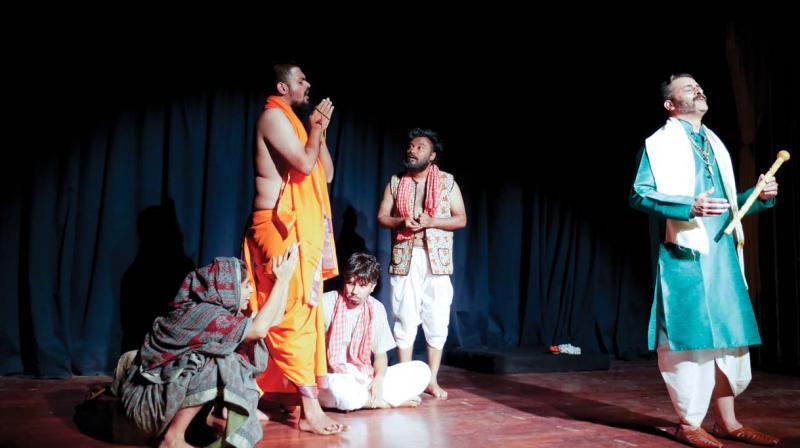50 shades of a play
After two previous performances, Prithesh came up with the idea of adding Yakshagana to make it more appealing.

A modern adaptation of Rabindranath Tagore’s play – Red Oleanders – blends the strength of his writing with the drama of Yakshagana to create compelling viewing on September 7 at the Bangalore International Centre in Domlur
The charm of Rabindranath Tagore’s narrations has not faded. Red Oleanders, a 90-minute play, is one amongst his drama collections which still exudes the same freshness and is as relatable to the contemporary world as it was to his epoch.
The plot captures the crux of the crisis of current civilisation, depicting modern man’s dilemmas and society’s materialistic approach. The story line shows both the good and bad in life, and since Tagore depicts evil as larger than life, the play uses Yakshagana, the dance of Gods, to portray these characters. This is probably the first time that this dance form has been incorporated in a Tagore play.
Director Prithesh Bhandary believes that this version of Red Oleanders will transcend boundaries of age or gender and appeal to a wide audience thanks to the contemporary nature of the dilemmas it deals with, taking viewers on an intense journey along the way. He says, “Tagore’s writing, with all the symbolism involved, is so relevant even today. His simple words are not difficult to understand, but there’s always a hidden message. So it was a bit of a challenge to understand the underlying dynamics of the play and to coordinate and bring everyone on stage. Shaping the play eventually, I added elements like Yakshagana, dancing and singing and we use the stage to the fullest, to show clear movements and engage the audience.”
Subhabrata Kundu, who plays the role of a mad man, says, “This role is quite tough. With many endearing qualities, this character is not outright mad. He is learned and has chosen to make better lives for the poor and revolt against the system. The motivation behind playing this role was to enact the dynamic and unpredictable character of Bisu, which is challenging. What I liked most about my character is his simplicity in spite of his knowledge and the way he uses it to decode any situation. All the play is trying to convey is that the system lures common folks into it and crushes them under its wheels, but that it requires only simple love to conquer and break the cruel system.”
After two previous performances, Prithesh came up with the idea of adding Yakshagana to make it more appealing. The king’s character being literally ‘king size’, the director modified the script to add the dance form. The actor had to painstakingly learn and implement it in his role. Laban TP, who plays the spoilt king and learnt Yakshagana for this play, says, “Not every script allows characters to be multi-faceted. This drew my attention as it is not just a play but also engages with the audience’s curiosity. The unique fusion of Yaskshagana with Tagore’s play had me learn, practice and perform the dance form which showcases various shades of the king.”
He explains how, with the help of the director, he visualised the story with the dance form. He recalls, “Prithesh explained to me how he would like the delivery of dialogues coupled with Yakshagana to look like on stage. The costumes added more regality to the character. It was extremely challenging in the beginning but then later, with continuous practice with the movement team, we picked it up well enough for the play.”

